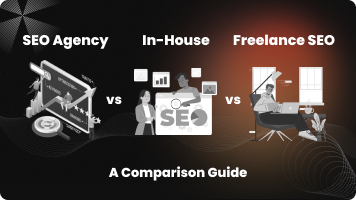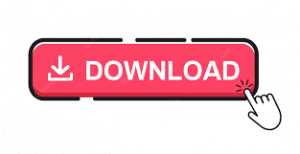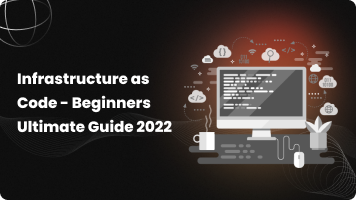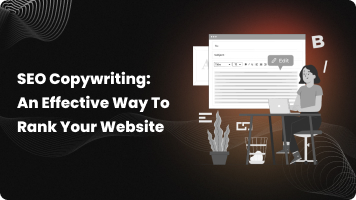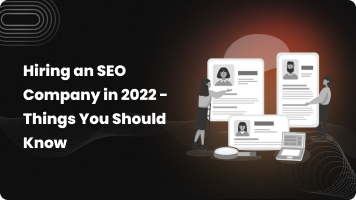Loveneet singh
SEO Agency vs In-House vs Freelance SEO [Comparison Guide]
Click Play Button to play audio:
Do you expect SEO to work? Are you looking for game-changing, cost-effective, lead-generating SEO results? Have trouble deciding whether to hire an SEO agency, in-house team, or freelancer?
It doesn’t take a pro to do SEO but choosing the right option for your website is a big decision. When you are hiring an SEO agency or a freelancer, don’t get carried away with promises of agencies. Rather, look for the SEO agency that can optimize your website for the growth of your business.
It doesn’t matter what industry you are in or whether you have a small, medium, or large business; a good SEO choice will help you promote your business effectively.
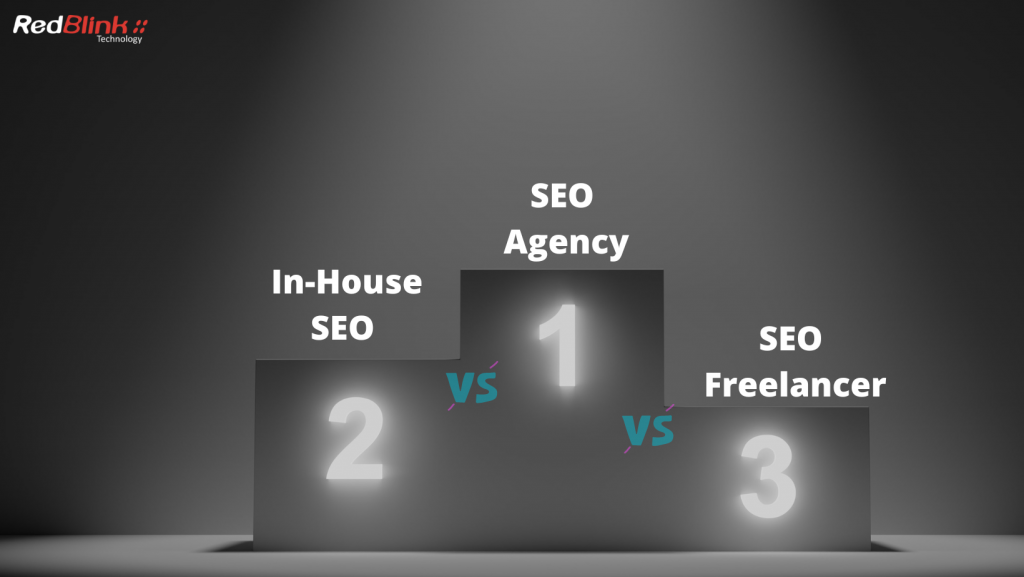
Takeaways:
-
Optimized Content to boost your SEO efforts
Search engine optimization (or SEO) is an ever-changing field. But throughout all these changes, one thing has remained constant, and that’s the importance of content to SEO. Actionable insight into how businesses can use content to support their SEO efforts. (Read More at: SEO Copywriting: An Effective Way To Rank Your Website )
-
Start your SEO project with a Free Audit Report
The world of SEO is complex and fast-changing. There are too many options in hand to start your SEO project. Finding a result-driven service depends on your research. Therefore. it is of great importance to choose a qualified SEO service provider that is ready to communicate and understand your business needs and goals.
For learning more about SEO, read: What Is SEO & How Do Search Engines Work
The post will help you to decide on the best option for SEO marketing. Also, we will explore the pros and cons of an SEO agency, a freelancer, or an in-house consultant.
Know your SEO Goals
The type of business partner to launch your marketing campaign will depend on. A leading SEO company that focuses on SEO goals like reducing bounce rate, getting backlinks and increasing page speed. Read our post on Top SEO goals for 2024 for more information.
-
Budget and Cost
Most companies sets a limited budget for SEO as it comes after web design, web development and other things. Depending on the requirements and budget, you decide whether to pick a SEO freelancer or an SEO agency. Setting up in-house SEO team is costly and not recommended for startups and companies having low budgets.

If you plan to hire an agency, you need not look for a costly effective option. You can divide the tasks, and as per your allocated budget, you hire the best SEO agency. Outsourcing to an SEO agency providing an all-in-one service is the latest and successful trend.
-
Required Expertise and Availability
Many factors can affect the digital marketing campaign. An SEO specialist working as a freelancer or hired in an in-house team can justify the job. But for a long-term commitment, organizations rely on SEO services ready to deliver desired results within a timeframe using White Hat SEO Techniques. If you think that the matter is becoming too serious, don’t get panic. Search for the best SEO agency nearby and talk to them about your project. You will get first-hand experience to know their skills.
-
Business Model
If SEO and digital marketing are critical for your business, especially for businesses looking for lead generation, you must focus on increasing the allocated budget with a mission to hire an agency that can increase visibility and traffic. From a business perspective hiring an SEO agency is worth it.
How to Aim for More Revenue/ROI through SEO?
The expected result of any campaign is the ROI. However, the increase in organic traffic is the first indication that SEO has started paying off. If your SEO strategy is pitching right then ROI can easily improve by 40-60% within 6-8 months.

However, the results vary depending on your business, products, and market competition. SEO results are transparent. You can evaluate the website traffic and lead generation with the help of tools like Google Analytics.
The companies keep different targets to improve ROI. ROI is also a measure of brand value, digital assets, increase in traffic, and so on. Every revenue-driving action needs to be identified, assigned value, and tracked to calculate ROI.
As a whole, some of the SEO Revenue generator strategies are
- Increasing traffic and driving qualified leads
- UX improvements for customer interaction
- Driving direct leads by running campaigns
SEO is a long-term investment and mainly aims for exponential growth. Ensuring higher visibility on SERPs month after month is the successful outcome of SEO.
How Long Does it Take to See ROI from SEO?
Like any marketing channel, ROI (return on investment) from your SEO is the main objective. activities. Calculating your ROI from SEO doesn't involve complex formulas when compared to paid traffic, the website traffic as shared above will show success.
Within three to six months, SEO results are visible. But it's not fixed. Sometimes, it takes time to get the result.
If you are moving with the right keyword intent and content to do on-page SEO, eventually the website will rank at the top of the sales funnel, priming your business for future sales.
ROI is further improved by integrating SEO and Paid Search campaigns. Some of the factors that can minimize the time to see results are
- Know the competitor's business before you plan a new SEO campaign.
- Know your target audiences
- Know your focus area as per the search engine criteria
- Know the budget of SEO and develop the strategy to minimize the cost/month.
Finally, before starting the SEO project, review the strategy and develop a unique method to minimize the time to get ROI through SEO.
How Outsourcing your SEO Services Benefit Your Business?
Since we all agree that SEO is the backbone of any online business to run, we can look at the latest trends to hire SEO agencies. Today, 90% of marketing agencies, internet companies, and countless other digital companies outsource their SEO projects to top-ranking SEO agencies. The benefits of outsourcing include:
- Time-saving as SEO companies have the dedicated teams and resources to start the project after the initial audit of the website.
- SEO companies have an experienced team that is in sync with the latest SEO strategies that can help in ranking
- The outsourcing of the SEO project will relax your mind as the SEO agencies have the resources to do the job the right way. Moreover, you can get the weekly or monthly report to know where you stand and how much is progress.
# Pros and Cons of Hiring a SEO Freelancer
Freelancers are certainly the most affordable option but remember “cheap” is not always the best. If you want to achieve short-term success through SEO then freelancers are the best choice.
But the fact is – one person can not do all. In freelancing work, you will not get coverage and varied ideas. Teamwork is the main missing factor. Also, freelancers handling many projects, and cant provide 100% attention on your project is something unexpected.
Over the last few years, many experienced SEO specialists have started working as freelancers. Hiring a freelancer for an SEO job is beneficial for many reasons:
-
Affordable pricing:
The price of hiring a freelancer is much less than hiring an agency. You can hire them on an hourly basis rather than hiring full-time. But if the company wants to run multiple campaigns and there are multiple websites on which SEO is required then the prices go up almost equal to hiring an agency.
-
Flexibility:
95% of freelancing jobs match your requirements and time schedules. Freelancers offer a flexible schedule as per the time zones. They have flexible hours and are always ready to take on a new project. So if you hire an SEO freelancer, the job will be done faster.
-
Reporting and responsibility:
When you hire a freelancer, you will need to review his/her work or take the feedback. Sometimes, the person might have expertise in one domain but not be aware of the nature of your business. He is sometimes unable to produce the desired results. Relying on one person and keeping the company's growth at stake is not a good option especially when your business is at a growing stage.
# Pros and Cons of Hiring an In-House SEO
In-House SEO is the least recommended option for startups and small-scale companies. In-house team is probably the option for enterprises. You can hire a professional team for regular SEO of the in-house projects. Some of the benefits of hiring an in-house team include
-
Confidentiality:
In-house SEO managers concentrate only on in-house projects therefore they can generate unique strategies. This business model guarantees confidentiality and ensures success through SEO.
-
Expertise:
A full understanding of the products and nature of business including the client’s requirements helps in generating impact through an SEO campaign. The success probability in less time is high.
Some of the cons of an in-house team are:
- High risk of losing the search ranking as the enthusiasm will be lost with due course of time
- Insufficient training for managers as they are working only on in-house projects
- high investments as you are managing the entire team for in-house projects
# Pros and Cons of Hiring an SEO Agency
Well, it's a big decision. There are many leading SEO agencies that have gained the trust of many companies. They have helped businesses in improving their search engine ranking and build brand awareness. The quality that they provide is superior to freelancers and in-house teams. Let’s see how you can benefit from that.
-
Professional and Experienced Staff
Digital marketing agencies hire SEO specialists in the field. They keep on grooming themselves by learning the changing market trends. The experienced staff sits together to develop a unique strategy for every project. This approach helps in improving the ranking and driving traffic.
-
Teamwork, Timing, and Strategy
Outsourcing SEO project to SEO agencies are beneficial as there is a dedicated team who is handling your project. The agencies choose the teams that are most suitable and have prior experience working on similar projects. Moreover, to run a successful campaign, you need experienced SEO project managers, content writers, digital marketing experts, and so on. This kind of teamwork is possible only with an agency setup. When so expertise combine to develop a strong SEO strategy the chances to get breakthrough success increase.
-
Reporting and Analytics
SEO is based on using optimized SEO tools and generating reports. Therefore it is important to hire a trustworthy SEO agency that can guarantee growth through SEO. Expertise in report generation and expertise in using analytical tools is required for higher search engine ranking.
-
Pricing
SEO agencies no doubt cost you more when you compare it with the freelancing option. But optimizing your needs and finding a way to do SEO will improve your web traffic.
The cons of agencies providing SEO services
When you consider feedback and reviews, some people do not like to hire SEO agencies. Some of the cons of hiring an SEO agency are:
- Difficulty to find the right SEO agency for your product. Make sure you check their latest SEO case studies.
- No single responsible person can sometimes irritate the clients.
- Budget for individual services goes high.
Conclusion : Which SEO Option is Best for your business?
The ultimate aim of SEO is to maximize profit by targeting traffic to your website. However, the important step remains to select the right way for your company’s SEO project.
The post discusses the pros and cons of a freelancer, in-house team, and SEO agency. One of the most significant decisions when choosing the right option is to consider the nature of your business and the risk of getting penalized by search engines.
As company owners or marketing heads, we must not forget the reality that one mistake can ruin the online reputation and damage brand value. So, you need to consider every factor before making a final decision.
Of course, there are competent freelancers or in-house SEO managers, but agencies provide you with more confidence at the professional level.
The need for SEO success plays a vital role in organizational growth. In any case, no company affords to lose the SEO battle. Therefore researching and analyzing the best option for meeting your business goals is the best option.
Now you know the pros and cons of all the options, a final word of advice, keep in mind that SEO takes time. No matter what option you choose, don’t expect results overnight. But if you invest wisely in long-term ranking strategies, you will see positive results. Hiring a top SEO agency such as RedBlink Technologies for the long term is the best option.
Also Read -
- Best AI SEO Software That Works for SMBs
- Best Low-code or No-code Platforms List
- Best Free Marketing Tools for Smart Marketers
How to Become a Golang Developer in 2024 - A Roadmap
(Estimated reading time: 6 minutes)
Go Developer Roadmap 2024
Feel Lazy Reading A Blog Post. Here is its audio version
Becoming a Go developer is no longer a job for programmers, its a lifestyle. With endless creativity, flexibility and the ability to share with others, Go developers are some of the most talented people in the business world today. This is what makes learning Go so worthwhile – there will always be new challenges and ways to improve your skillset.
Lets take a look at how you can get started developing with Go before 2024…
Introduction to GoLang
Go (also known as GoLang) is an in-demand backend language, especially for the tech guys working with Google products. It is a proficient language to compile large programs in seconds.
Competitive companies like Uber, Twitch, Netflix, and Paypal are embracing this language. People looking for a developer's job can have a kick-start career by learning GoLang.
If you are thinking - where do you begin? Would it be a good decision from a career perspective? What salary package is offered? What certification course to do for becoming a Go developer?
This post answers all your queries. Above all, it will serve as a guide to know how can you become a Go developer and get hired in the best software development company.
What is GoLang?
Google developed a statically typed programming language in 2009 for compiling large code in less time. The programming language inherits the efficiency of famous languages like C++ and the readability of Python.
GoLang allows the development of functional websites and software applications. It uses different tools and frameworks mainly focusing on testing and debugging already developed code.
Building a career in Go is easy for developers who already have programming experience in the following:
- Knowledge of scripting languages like Java, Shell, Pearl scripts
- Understanding of UI/UX and application design software
- Working knowledge with Git
- Knowledge of DevOps practices
Why should you become GO developer?
Given that Go is still a relatively new language, there isn't much competition for developers.
Go is a hybrid imperative language designed keeping the concept of concurrency in mind. Some of the key features of the language are:
- Does not support polymorphism with respect to functions and operators.
- Class or type inheritance is not used
- Dynamic libraries do not exist
- To avoid memory loss, implicit type conversion is not allowed.
So, why not grab this opportunity by starting learning Go? According to Stack Overflow's 2020 Developer Survey, Golang moved up to the fifth place from ninth place in 2019 on the most loved languages list.
How to become a Go Developer?
Go (or Golang) is developed with an open-source programming concept focusing on fast-execution reliability, and efficient software at scale. The language is efficient to work with large networks of servers and cloud-native infrastructure.
As Google services are one of the prominent services for web and cloud environments, a language like GO will become popular in the coming times. A step-wise process to learning Go is :
Step 1: Learn the basics of Go
To start with, you must have sound knowledge of the scripting language. The route toward learning Go starts as;
- Filenames, keywords, identifiers
- Operators, types, functions, and constants
- Pointers, structures, methods
- Maps, arrays, slices
- Go CLI
- Interface
- Error handling
- Goroutine, Channel, Buffer
- Panic, Defer, Error, Recover
- Go design patterns
However, your learning speed depends on your programming skills and experience in programming. For new learners, it’s best to start with the basics while experienced developers can directly start programming with Go with the help of online tutorials.
Go uses the concept of less coding and complexity using a minimal amount of keywords. Therefore the LoC will be lesser than other languages like Java. Keywords in Go are passed without a symbol table, as its grammar is LALR(1). The language acts as a hybrid, imperative language using the concept of concurrency.
Step 2: Master Go libraries and other tools
After gaining the basic knowledge, you should learn the add-on libraries and tools that make Go easier to use. As a Go developer, you should have the working knowledge with:
- Go dependency management tools
- Semantic versioning
- Scripts and repositories
- Go libraries
- SQL fundamentals
- GIT
- Basic authentication
- HTTP/HTTPS
- Web frameworks and routers
- Relational databases (PostgreSQL)
You can spend extra hours learning Go Frameworks, Libraries, and databases.
- Common Go Frameworks - Echo, Gin, Revel, and Chi
- Common Go Libraries- Go Kit, GORM, Gen, and CL
- Common Go Databases- PostgreSQL ,MySQL.
However, knowledge of log frameworks such as Zap will be an add-on skill.
Step 3: Learn to test with Go
Testing the code plays a vital role in the success of a Go developer. The usability and reliability checking are two important testing phases of GO development including:
- Unit testing (important testing phase in Go)
- Integration testing
- Behavior testing
- E2E testing
Some of the popular testing frameworks are Ginkgo and GoCheck. Ginkgo is mainly used for behavior testing and integration testing.
Step 4: Understand Go patterns
Understanding Go design patterns is a must because Go uses repeatable general solutions to common problems. Go focuses on the following design patterns:
- Structural
- Creational
- Behavioral
- Concurrency
- Stability
The most important are creational (such as builder, factory, singleton), behavioral (such as using them as iterator, observer, command), and structural (such as adapter, bridge, decorator).
Experienced developers must be aware of the design patterns they can start in the context of Go. The freshers can start by borrowing some sample implementations.
Take-Away Skills:
- The setup of a Go environment and how to create a Go file.
- Go’s data types and variables.
- Go’s conditional statements.
- Using functions in Go.
Online Courses and certifications
If you have decided to learn GoLang, here are some of the online courses that will you master the language:
- Go-The Complete Developer’s Guide (Golang) — Udemy
- Go Programming (Golang): The Complete Developer’s Guide
- Programming with Google Go Specialization (Coursera)
- Go Fundamentals By Nigel Poulton (Pluralsight)
- Learn Go on Codecademy
- Go (Golang): The Complete Bootcamp (Udemy best Course)
- Learn Golang in 7 hours (FreeCodecamp channel Youtube)
- Go/ Golang Crash Course — Taversy Media Youtube
- Introduction to industry REST microservices in Golang (Go)
- Golang Mastry by Boot.Dev [Interactive Course]
Salary Packages of Go Developers
The salary package of a developer depends on the expertise level. For the entry-level positions, the expected salary is $117,000 per year which can go up to $170,000 per year depending on the work experience. At present, for remote developers, there are ample job opportunities that can boost a developer career.
GoLang Developer Roadmap Free Download
FAQ - GoLang Developer Roadmap 2024
1. Why learn GoLang?
Software developers face inevitable challenges especially related to concurrency. Go is created to do automatic memory management. To add on, Go is designed to handle server-side complexity in executing code.
2. Is it worth learning GoLang in 2024?
Definitely! Go is a popular language used for Google services. As per the statistics from Github, the Go community has grown by 147% between 2018-2019. Go is worth it because it is compatible with languages like Python, Java, C, and C++.
In the present times, it is a fact that no new programming language can fulfill all the programming needs. To become a versatile programmer, you must learn multiple programming languages. When it comes to choosing a trend language, Go will definitely give you a salary hike.
3. What's next for GoLang Developer 2024?
If you are starting to learn a language like GoLang, there are limitless opportunities. A lot lies ahead depending on individual efforts. Pursuing an online course for learning the basic concept and taking hands-on experience can prove your worth in the programming field.
You can even enroll yourself with a renowned software development company in San Francisco that hires fresh trainees to learn GO from the scratch and covers topics such as error-handling, networking, and templating. You will have exposure to working on real-time projects. You will gain experience handling bugs, and complex patterns.
By the end of the course, the company will provide a certificate, and who knows, the top-most software company working in GoLang might hire you!
Infrastructure as Code(IaC) - Beginners Ultimate Guide 2024
(Estimated reading time: 10 minutes)
Infrastructure as Code (IaC) – An Introduction
Are you looking for a software solution that manages networks, virtual machines, load balancers, and connection topology? Does your operations team is looking for a cloud solution for software-defined infrastructure?
In IT practices as we use DevOps to utilize the source code, infrastructure as code (IaC) is used to automate the provisioning of infrastructure. It enables your organization to develop, deploy, and scale cloud applications with greater speed, less risk, and reduced cost.
The concept is similar to programming scripts. However, scripts are primarily used to automate a series of static steps that are repeated numerous times across multiple servers.
This post discusses the concept of Infrastructure as code, its use, and the scope of IaC in the future
What is Infrastructure as Code?
Infrastructure as a code is a higher-level or descriptive language to code more versatile and adaptive provisioning and deployment processes. For example, for IT management and configuration, you can install a MySQL server, verify that MySQL is running properly, create a user account and password, set up a new database and remove unneeded databases.

More clearly, infrastructure as code is defined as:
- Allows infrastructure to be easily integrated into version control mechanisms to create trackable and auditable infrastructure changes.
- Provides the ability to introduce extensive automation for infrastructure management. All these things lead to IaC being integrated into CI/CD pipelines as an integral part of the SDLC.
- Eliminates the need for manual infrastructure provisioning and management. Thus, it allows users to easily manage the inevitable config drift of underlying infrastructure and configurations and keep all the environments within the defined configuration.
What is the need for IaC?
Once upon a time, when a business wanted to run the software, its only option was to order some physical equipment and internet access from a network provider. These data centers had to request the networking companies weeks or months in advance, and then manually provision them on-site. This required a physical location with cooling systems and countless hours to perform installations and maintenance operations.
But then, public data centers came along that could manage the servers of other businesses. Some big giants started server services by maintaining public data centers. That justified the need for a setup like IaC.
With this setup, you will :
- No need for dedicated and costly server rooms.
- Will potentially lower lead time for common servers and networking items.
- Physical management of servers/equipment handled by the data center provider.
- Freeing up valuable resources.
Once the cloud setup became accessible with the help of APIs, the trend of handling provisioning and management of resources with the help of scripts and automated tools became prevalent. So now, once the physical equipment is installed in a cloud or virtual setup, and rest all the processes are automated, including the provisioning of all virtual hardware resources.
With IaC, the provisioning and configuration of resources are described in scripts, which are read by tools that communicate with the public cloud API to make sure reality matches the desired state.
What Problem Does IaC Solve?
The IaC as of date addresses the following issues:
- The cost and hassles of maintaining individual physical resources are drastically reduced.
- Speed, scalability, and configuration issues are maintained by the service providers.
- Monitoring for detecting viruses and threats and fixing privacy issues are easily handled as the infrastructure is equipped with advanced software scripts.
- While we maintain individual setup, there is inconsistency, and unavoidable discrepancies thus transferring data and applications becomes difficult.
Benefits of Infrastructure as Code
Virtualization and cloud-native development eliminate the problem of physical hardware management, enabling virtual servers or containers on demand.
But some developers like to still code by themselves. But as offers, a cutting edge enables versioned infrastructure with numerous benefits.
-
Faster time to production/market:
IaC provides faster operations as the infrastructure is already maintained. To access it, you need to run pre-executed scripts. The only process you need to maintain is faster ticketing to speed up the operation.
-
Eliminates Time-Consuming, Routine Work
Mismatch of the hardware and software is always a critical issue when it comes to the deployment of applications. This raises the risk of vulnerabilities and security threats. IaC prevents drift by provisioning the same environment every time.
-
Friendly and efficient development:
It is noticed that the SDLC time is reduced with the implementation of IaC. Sandboxes and integration/continuous deployment (CI/CD) environments have provided a way to run standard and tested software. The testing environment saves time and thus helps in completing the software cycles in a faster and more effective way.
-
Protection against churn:
IaC maximizes efficiency and dependency on infrastructure. If one employee leaves the organization, it will hardly affect efficiency. This independence helps the employees to work freely without taking the tension of maintaining the server setups. Also, it reduces the work of IT administrators.
Cloud Computing: as a Solution to IaC
Cloud solutions are a well-accepted platform for most of the development work. The concept of maintaining containers and adapting to virtual coding styles is much easier than implementing and executing the individual code. Cloud solutions have moved ahead by providing IaC solutions. All you need to do is to balance the pros and cons according to your context when selecting one of the IaC styles. Some of the things you should consider are:
- Choose The Correct Tools
- Use Version Control
- Avoid Manual Infrastructure Changes
- Test Your Infrastructure-as-Code Templates
- Be Cautious With Sensitive Variables and Parameters
- Write Precise Code Rather Than Documentation
- Write Modular Configuration Files
What are the key challenges for IaC?
It is a fact that IaC adds a lot of value to the IT environment but there are a few challenges that can not be overlooked. Remember to account for your unique IT situations that might make the following more or less relevant (like organization size, state, and your technology adoption lifecycle). To utilize the IaC environment to its full capacity, you need to avoid the following challenges:
-
Minimize Coding language dependency:
Some of the popular languages used in IaC are JSON, HashiCorp Configuration Languages (HCL), YAML, Ruby, etc. The shortage of these skill sets can hamper your IaC usage potential. Also, is your strategy to move away from development and make things serverless? Think of the strategic direction in which you are heading before you jump into IaC.
-
Security assessment processes:
When you are about to make a shift to a new environment, you have to do manual security checking of the existing security setup. In most cases, you need to match up with the high-end security setup used in IaC. There is a need to take extra steps to ensure you’re establishing guardrails for complete governance.
-
IaC monitoring and synchronization:
Additional tools are required to monitor the smooth working and track the provisioning with the additional setup. This might increase the initial cost but in the long run, it is going to be beneficial if you deploy proper syncing methods using appropriate licensed tools
What are the types of Infrastructure as Code?
As we require to run different types of applications with and various types of software configurations, we have the options to select among the types of infrastructure as code services:
# Depending on the Tools Used:
-
Declarative Infrastructure as Code
A declarative approach requires only the end requirement of the user. The setup itself suggests the specific tools or platforms meet the requirement. The declarative approach is preferred in most infrastructure management use cases as it offers a greater degree of flexibility when managing infrastructure. Some of the tools used are Terraform, Pulumi, CloudFormation, ART, and Puppet.
-
Imperative Infrastructure as Code
An imperative approach allows the developers to define the steps to deploy changes. The system does not deviate from the specified steps. Chef is considered an imperative tool. Uniquely, Ansible is mostly declarative with support for imperative commands.
# As per the infrastructure setup:
-
Mutable infrastructure
Mutable infrastructure is the infrastructure that can be modified or updated after it is originally provisioned. Mutable infrastructure gives development teams the flexibility to make ad hoc server customizations. It allows addressing running issues like security threats. But this type fails to utilize the key feature of IaC which is the ability to maintain consistency between deployments or within versions. It makes version monitoring tough.
-
Immutable infrastructure
Immutable infrastructure remains stable once originally provisioned. If immutable infrastructure needs to be changed, it has to be replaced with new infrastructure. Because new infrastructure can be spun up quickly on the cloud, especially with IaC, this setup is more useful and feasible. The consistency is easily maintained between the test and deployment stages. It solves version monitoring issues as and when required.
How Does IaC Work effectively?
Choosing the types of IaC will serve as the basic requirement. At this point, it is to note that IaC is independent of languages but choosing the best suitable requirement will allow you to receive the best practices. Some of the IaC deployment strategies are :
- Make code your single source of truth.
- Version control all of your configuration files.
- Use little documentation for your infrastructure specifications.
- Test and Monitor Your Configurations.
How does IaC differ from infrastructure as a service (IaaS)?
Importantly, the IaC concept is not a derivative of infrastructure as a service (IaaS).
Infrastructure as a Service is one of the core cloud services that allows the virtualization of resources. such as servers, networking infrastructure, storage, etc
Infrastructure as Code is a tool that can be used to provision and manage infrastructure. It is not limited to only cloud-based resources. You apply IaC to a wide variety of environments, including on-premises.
Infrastructure as Code tools & platforms
While many open-source IaC tools are available, some of the most commonly adopted tools are:
Terraform by HashiCorp is the leading IaC tool to manage cloud-based infrastructure across various platforms from AWS, Azure, GCP to Oracle Cloud, Alibaba Cloud, and even platforms like Kubernetes and Heroku.
As a platform-agnostic tool, Terraform is used to facilitate infrastructure provisioning and management use cases across different platforms. It ensures the desired state across the configurations.
Ansible is an open-source configuration management tool with IaC capabilities. It is not specifically designed for IaC but supports both cloud and on-prem environments. It can act through SSH or WinRM as an agentless tool. Ansible excels at configuration management and infrastructure provisioning. However, it has limited management capabilities.
Pulumi is one of the latest tools to provide a developer-first IaC experience. Pulumi offers the freedom to use any supported programming language as the developer requires. This tool supports Python, TypeScript, JavaScript, Go, C#, and F#, and the state is managed through the Pulumi service by default.
Chef and Puppet are two powerful configuration management tools. Both aim to provide configuration management and automation capabilities with some infrastructure management capabilities across the development pipeline. Chef is developed to deploy DevOps practices with greater collaboration tools. Puppet evolved by targeting sheer process automation. Today, Puppet has automated built-in watchers to identify configuration drift.
CFEngine is another tool that solely focuses on configuration management. Even though there is no capability to manage the underlying infrastructure, CDEngine can accommodate even the most complex configuration requirements, covering everything from security hardening to compliance.
CloudFormation is the AWS proprietary platform-specific IaC tool to manage AWS infrastructure. CloudFormation has deep integration with all AWS services and can facilitate any AWS configuration as a first-party solution.
Microsoft Azure uses JSON-based Azure Resource Templates to facilitate IaC practices within the Azure platform. These resource templates ensure consistency of the infrastructure and can be used for any type of resource configuration.
In addition to the above, there are specialized tools aimed at specific infrastructure and configuration management tasks such as:
- Packer, EC2 Image Builder, and Azure Image Builder create deployable custom OS images.
- Cloud-Init is the industry-standard cross-platform cloud instance initialization tool. It enables users to execute the script when provisioning resources (servers).
- (R)? ex is a fully featured infrastructure automation framework
The future is to adopt quick, trackable infrastructure changes
Infrastructure as a Code offers one of the advanced techniques to deploy modern applications. You can leverage quick and trackable infrastructure changes that directly integrate into CI/CD platforms. Infrastructure as Code is crucial for both:
- Facilitating scalable infrastructure management
- Efficiently managing the config drift in all environments
Getting started with Infrastructure as Code may seem daunting with many different tools and platforms targeted at different use cases. However, with the planned strategy, you can cross this hurdle by building a powerful infrastructure management mechanism.
References:
https://www.ibm.com/cloud/learn/infrastructure-as-code
https://docs.microsoft.com/en-us/devops/deliver/what-is-infrastructure-as-code
https://www.bmc.com/blogs/infrastructure-as-code/
https://stackify.com/what-is-infrastructure-as-code-how-it-works-best-practices-tutorials/
SEO Copywriting: An Effective Way To Rank Your Website
(Estimated reading time: 7 min)
How SEO Copywriting Can Improve Website Rankings
In the success of SEO campaigns, content marketing plays a vital role. Among the two branches of content creation, SEO copywriting and SEO content writing are more prevalent.
These content generation methods have revolutionized the way marketers reach, engage, and convert their leads into customers.
For an SEO strategist, knowing the difference between copywriting and SEO writing will help to create profitable SEO campaigns.
We have already discussed about SEO Content Writing vs Creative Content Writing in the previous posts. In this post, we will discuss more about SEO copywriting, its benefits and how it can maximize SEO marketing strategies.
What is SEO copywriting?
SEO copywriting is a practice of producing keyword-optimized content designed to appeal to end users and search engine algorithms.
The optimized content should be readable, linkable, and sharable among the various online platforms. Writing only from the Search engine's point of view might look robotic therefore copywriting focuses on the authenticity and relevancy of the content.
To put it simply, it is the art of creating helpful, captivating, and valuable content that targets keywords as per SEO requirements.

The practice of creating content must incorporate unique and valuable concepts that can encourage the viewers to make a visit to the website and make a purchase.
One more concern is to meet the competitive landscape to create a marketplace. Creating a brand value and a good reputation among competitors and users is the main motive of copywriting. The core skills of a copywriter are:
- Include keywords in writing headlines
- Learn to write a value proposition
- Learn to create an optimized landing page without using duplicate content
- Writing sales emails is a must
- You should be able to write advertising content
- Writing optimized video script content
- Avoid keyword stuffing and maintain keyword proximity
SEO copywriting Vs SEO content writing
Copywriting and SEO writing are the two different disciplines of content marketing. They have certain similarities among them with the same objective. The main goal is to create content that can help in improving the search engine ranking and thus improve website traffic. But both apply different methods to achieve the same goal. Now let's get to know in detail.
SEO Copywriting
Copywriting focuses on SEO- friendly writing strategically aiming at producing brand awareness. It is defined as persuasive writing for business promotion. It covers a multitude of projects such as:
- Web pages
- Landing pages
- Print advertisements
- Video and audio scripts
A copywriter incorporates different elements to drive SEO campaigns:
- Aim to target audiences
- Ability to touch the reader’s emotions
- Applying innovative techniques to develop keyword-optimized, eye-catching content
SEO Content writing
SEO content-writing is the creation of creative content as per the SEO requirement. The content thus created will help to gain a high ranking on search engines like Google, Bing, DuckDuckGo and others.
SEO content writing mainly focuses on on-page SEO activities considering the working of search engine algorithms and end users’ expectations. An SEO- friendly content involves writing content with the user in mind. Some of the key components of SEO content writing are:
- Keyword research
- Content as per the latest algorithm changes
Main Differences between SEO Content Writing and SEO Copywriting
Various kinds of websites use different writing styles to address the needs of clients. Since copywriting and content writing, both are strong SEO writing styles, let’s get to know the differences between the two:
-
Optimization Methods
Both types of writing are optimized to meet different goals. For website pages, we, write SEO content while for TV commercials, print ads, or product labeling, we use copywriting style.
-
Usage
The online content is categorized as informative and promotional content. SEO writing is more comprehensive. It is used for longer-form content like articles and blog posts whereas copywriting is a promotional content creation used to create a brand value of a product or service.
-
Target audience
Approach to answer the queries of target audiences makes a big difference. SEO writing is mainly about writing the content to introduce the product. Copywriting, on the other hand, considers that the target audiences already know about the product and leaning toward buying it. For example landing pages for paid campaigns.
The main motive of SEO copywriting is its purpose, mainly calling people to action and boosting SERP rankings of the content.
For good SEO practices, the content writers must use both styles in combination. It is required as per the latest SEO guidelines.
SEO Copywriting Tips and Best Practices
If you have got a fantastic product or service, then writing content for the same is tough. The market competition will be more. For example, if you are performing a search like “top SEO agencies”, only the leading companies will appear on the first page. If you add a location to this search like “top SEO agencies, Danville CA”, the chances to appear will increase to capture the data from “Danville, CA ”( local search).
Many startup companies face this business challenge and opt to choose content optimizing techniques. If you hire a professional company that provides optimized SEO -friendly content might suggest many innovative ideas. You can receive SEO benefits and can rank better on search engines.
It is always better to outsource copywriting tasks to professional agencies providing SEO services. Here are a few tips to help you produce optimized copywriting content:
- Check grammar and spelling by writing short sentences.
- Know the need and expectations of your audiences to create informative content.
- Consider the formatting of the text. Sometimes, too much information and selection of words become hostile.
- Make use of optimized keywords in the appropriate places. Including too many keywords in a single phrase is ineffective from an SEO point of view.
- Using long tails keywords is a good practice even for copywriters. The search engines can understand the context and would penalize it accordingly.
How to become an SEO copywriter?
SEO copywriting for beginners starts by developing an in-depth understanding the SEO practices. Competitive SEO campaigns require SEO copywriters to create useful, interesting, persuasive, and well-optimized content to have a high search engine ranking.
It is all about targeting specific keywords and nailing the user experience by promoting products and services.
As a beginner in the SEO content writing field, you can excel only when you have a flair for writing website content. Your content samples will act as the gateway to the get job in a reputed SEO agency.
Here is a step-by-step process that will help you become a successful copywriter:
- Take the help of online tutorials and note down the important points to start with
- Start writing content for social media marketing (email, Facebook, etc.)
- Take an online course to learn the tricks and tactics of SEO copywriting.
If you are looking for a high-salaried copywriter job then you must enroll yourself in a copywriting course from one of the reputed SEO agencies. Many institutes like Udemy or Coursera offer online courses. The fee structure depends upon the type and duration of the course.
Tools Used for SEO Copywriting
SEO Copywriting is done using AI-powered tools. These tools provide suggestions to improve the quality of the content without compromising user readability. Most of the tools are available for free, So, if you want to bring copywriting practice while creating SEO content, you can start using these tools:
- Ginger Software- A grammar correction Tool
- Grammarly- A grammar checking and content optimization tool
- SEMrush- A complete content optimization tool with a dashboard to generate SEO content
- Google Adwords- SEO advertising tools that can help you create competitive keyword-optimized content
- Inlinks – Helps you create optimized content
- Marketmuse- Suggests keywords as per the searches and improves the quality of the content
- SpyFu- This allows you to compare your content with your competitor's content
Here we have mentioned some of the AI tools that help you create engaging content. There are many other AI tools to help copywriters. There is no denying the fact, these tools will help you bring change in your writing style and create optimized content that can improve SEO ranking.
How Does Copywriting Help With SEO?
SEO copywriting meets the specific SEO goals and encourages readers to take an action. The ingredient of copywriting is to include catchy content. Some of the add-on features to include are:
- Include phrases and keywords that search engines can understand
- A copywriter answers the user's inquiry and turns a user into a buyer by providing relevant information
- Writing engaging and quality content to improve the value of content
- Analyzing the competition and writing outranking content
There is no doubt that for a successful SEO campaign, the copywriter can help you create quality content that will never penalize your website in Google ranking.
Last but not least, you should understand the market niche to generate strong content for SEO.
Copywriting ensures and justifies the right purpose of SEO content. To fully optimize your content, you need to hire a professional SEO agency like RedBlink technologies that can help you create quality content. Use this below button to schedule a meeting with us and discuss your content requirements.
Once you do so, you will be able to see the best results by yourself. To summarize, copywriting will be a profitable investment for your brand building!
Also Read -
- Best AI SEO Tools For Automation & Speedy Content
- Must-Have Digital Marketing Tools to Help You Grow
- Best Low-Code Development Platforms in 2024
Flutter Developer Roadmap 2024
(Estimated reading time: 10 minutes)
Roadmap To Become A Flutter Developer in 2024
Flutter is an application environment built by Google for building mobile applications. The platform can run on many devices, including Android phones, tablets, or laptops.
The editor for creating apps in Flutter is code. You write your app instructions in HTML, CSS, and JavaScript files called components. Each component contains the necessary functionality to perform a specific action within your app.
The beauty of this coding system is that it allows you to use any language you like to create your components and codes. Google offers lots of templates and samples that already have the functions you will need, cutting down on the work you must do.

Flutter stores its compiled forms in APK files. These are deployed onto your device, running as independent programs upon completion.
There are several advantages to using Flutter over other software development languages. It is also known as a cross-platform tool, serving as one example of a technology capable of producing high efficiency at low cost.
What is Flutter?
Flutter is an open-source mobile application development framework from Google. The main reason for its popularity is that it supports building cross-platform apps. Flutter is also used to create interactive apps that run on web pages or on the desktop.
Here are some features of Flutter:
The single code base for Android and iOS Mobile App Development
- This approach helps simplify and reduce development time and cost, and maintenance is also an easy task.
Hot reload function
- This feature allows developers and designers to see changes as they code.
Open-source and by Google
- Flutter is a popular choice among developers due to huge community support.
Dart Programming
- Flutter uses an easy-to-learn and easy-to-implement programming language called Dart, which is Google's general programming language.
Learn Basics of Dart
Flutter uses dart as a programming language. Dart is a powerful programming language to build apps faster. If you are familiar with a dart, it will be easier to build apps with flutter. Here is must-learn topic for the dart.
- Basic Hello World Program.
- Variables and Constants.
- Conditions and Loops.
- Lists and methods of list.
- Methods and types.
- Object-Oriented Programming.
- Class and Object.
- Constructors.
- List of Objects.
- Async and Await [Advance topic but will help later].
There are various websites and YouTube channels to learn Dart. Some of the best links to learn dart are provided below:
Benefits of Flutter for Mobile Apps in 2024
Flutter showed its potential just a few years after its official launch. This framework not only speeds up the app development process but also saves time and money.
-
Flutter: Very profitable
Compared to other cross-platform app development frameworks, Flutter is more cost-effective. It meets all the requirements of every company, regardless of its model and size.
With its code reuse feature, Flutter saves developers time. The “Write Once, Run Everywhere” concept holds true since a single code is used to develop an application for multiple platforms.
Small and medium businesses can choose this platform to build fast applications with desired features and excellent designs. Here, the cost of app development remains low as Flutter app development takes very little time .
-
Flutter: Faster Development
The growing popularity of Flutter has many reasons. The best of them is to offer the fastest results. Mobile App Developers can debug and test codes quickly. Meeting deadlines, reducing costs, and other resources and effort required to develop an application are significantly less important with Flutter.
-
Flutter: Excellent user experience
The Flutter-based UI can be installed on virtually any platform. It has its own rendering engine which allows developers to keep the user interface as it is while switching to another platform.
Therefore, app users can enjoy an excellent and same experience as a native app on various platforms.
-
Flutter: Range of Widgets
Flutter has a wide range of widgets. These widgets have extensive capabilities that allow developers to easily build complex interfaces.
Third-party plugins and widgets together help to make the development process seamless. The UI Toolkit makes the Flutter app development process more intuitive.
-
Flutter: Improved productivity
Flutter has a hot reload feature that allows developers and designers to coordinate efficiently and verify changes immediately without modifying code.
During the app development process, all UI changes are visible to developers and designers. This saves them time and effort.
-
Flutter: Safety
Google designed the Flutter framework with all modern app security concerns in mind. Reliable and well-tested plugins can be found in Flutter to mitigate security risks such as user authentication flaws, malicious code injections, and data breaches.
-
Flutter: Performance
As a cross-platform framework, Flutter offers unparalleled performance compared to its competitors. Flutter compiles designs to native code. Unlike React Native, Flutter renders widgets directly from the native library rather than downloading the libraries and components to the device before rendering.
Flutter is the best choice when you need a mobile app that offers a seamless user interface without incurring too high development costs. It's an ideal technology for companies looking to create an MVP, as well as businesses looking to bring a mobile app to market quickly.
Flutter’s platform gives you many new options for creating great user interfaces (UIs), including:
- Material design with gestures
- Cupertino widgets (including navigation drawer)
- Floating action button in favorite colors
- Rich text editing with Gesture Typing support
- Flexible and dynamic UI layout adjustments
- Tailored apps and permissions
- Extensions & unique to chrome OS
- Cross-platform messaging
- Icon fonts
- Advanced animations
As you can see our mobile app development is constantly evolving. With this in mind, it’s important to understand that there is an ever-present demand for new features within the Android platform.
Since Google invested heavily in promoting its material design language, more and more android apps are adopting material features. It is also worth noting that with Android maintenance done by engineers who work daily on the system itself, your device will always receive stable updates along with all of the latest improvements found in each update.
This contributes to the longevity of any application installed on your device. There are even several libraries available that provide additional functionality not included in the default software or stock versions.
With these additions, you can create unprecedented applications that may be otherwise impossible due to hardware limitations. Some use cases include but are not limited to real-time interactive experiences, high-performance operations, extensive offline capabilities, low power consuming modes, and many more.
Flutter Developer Roadmap - Learn Flutter App Development.


What to Start With First?
Since the release of Flutter’s first app, an iOS/Android IDE has become more prevalent than mobile software development ever had before.
With this increased exposure, it is becoming easier to get your foot in the door and start developing apps with Flutter.
What we recommend you start with is learning how to build upon Google’s own widgets (such as those used for sharing content) and implementing them into your own UIs.
This will help you gain experience and confidence as well as provide you with additional resources that can take your development further.
There are many great guides online that cover how to do this from both creating a new widget or building a plugin from scratch.
Why does Flutter Uses Dart?
As mentioned earlier, one of the main reasons to use Dart is that it gives you access to all of Google’s tools and infrastructure (e.g., Android Studio). This includes the compiler, code indexing/search, runtime, development environment etc. In fact, many people choose to use Android Studio for this very reason.
Furthermore, since your application will be running on Android, most of the time, you won't need to worry about bringing in external dependencies. You can focus on what you want to accomplish without needing to manage other parts of the system.
There are some things your app can do with Dart that it cannot do with JavaScript, like speed up navigation between pages or work well on mobile devices with limited hardware capability. Some examples are below:
- Your app may have several different interfaces, each with its own set of design considerations. With Dart, you can create them separately and then connect them together.
- You could have an interface for the home screen that utilizes hot reload, another for iOS that connects to Swift via Publish, and still others that utilize native components.
- You also have more control over how much memory your applications uses at run-time. Because you're not relying on third-party libraries as often, there's less overhead involved.
How to Install Flutter?
Flutter is essentially Google's Portable User Interface (UI) toolkit, used to create and develop eye-catching, natively-designed apps for mobile, desktop, and web from a single database. coded. Flutter is free, open source, and compatible with existing code. It is used by businesses and developers around the world, due to its user-friendly interface and fairly simple yet precise controls.
Here, we will look at the process of installing Flutter on Windows.
Follow the steps below to install Flutter on Windows:
- Step 1: Navigate to flutter.dev on your webpage. From the top menu bar, select Docs > First Steps > Install > Windows .
- Step 2: You can get detailed steps for installing the latest versions of Windows PowerShell 5.0 and Git for Windows if they are not already installed.
- Step 3: Restart the system after installing Git on your windows. Once done, let's move on to installing the Flutter Software Development Kit (Flutter SDK). Click the download link for the latest version (as of today).
Flutter SDK is the tool that allows us not only to create flutter projects, but also to create these projects and turn them into native mobile applications. In simpler terms, Flutter SDK is the main tool for creating flutter UI.
The latter one is not recommended as it might lead to bugs and problems with the application. Here, you can read more information about settings and permissions.
Once the zip file is downloaded, extract the "flutter" folder (drag and drop) to any system path/directory where you get read and write access. Generally, it's better to create a new folder in a separate directory from the system drive due to permission issues (in my case, the target destination is D: > development > flutter).
Run your first app
Do you also want to run your Flutter app on the web? The web version of Flutter is available as early support…
flutter.dev or you can use To run your first app flutter run and … and .. and
When you create your flutter app you will see there is already code for a counter app.
When you run the code, you will see this. This is a simple counter application where you have a FAB(FloatingActionButton) and Text which indicate how many times the FAB has been pressed.
Flutter Developer Salaries in USA
The salary of the Flutter developer evolves according to his experience, the scope of his various projects, and also his geographical area. Higher salaries are observed in the corporate region than in the others. The national average salary for a Flutter Developer is $72,166 in the United States.
In short, the salary of a Flutter developer in 2024 varies according to experience. The salary of a junior Flutter developer is around $35,000 per year, while the salary for a senior Flutter developer is $80,000 per year. This is one of the specialties with the highest labor demand, which is why it is easier to get the first job here.
Flutter Resources
Language
https://dart.dev/guides/language/language-tour
https://dart.dev/guides/language/effective-dart
Dart
https://pub.dev/packages/freezed
https://fsharpforfunandprofit.com
Database
https://pub.dev/packages/sqflite
https://pub.dev/packages/firebase
https://pub.dev/packages/moor
https://pub.dev/packages/hive
Architecture
https://fluttersamples.com
https://pub.dev/packages/flutter_redux
https://pub.dev/packages/flutter_mobx
https://pub.dev/packages/flutter_bloc
Package Manager
https://flutter.dev/docs/development/packages-and-plugins/developing-packages
https://cocoapods.org
https://maven.apache.org
Conclusion
Flutter is easy to use, quick to develop, and has a wide selection of third-party development toolsets.
It allows you to work in either a reactive or proactive fashion. With reactive development, the entire app runs within the browser, which makes it very fast. The downside is that there are limited options for deploying the final product; you can only deploy to iOS or Android devices through their respective app stores.
With proactive development, your code is compiled into actual files which are deployed onto your device. This process can take some time, but you have more control over what happens to your data. You can actually run apps from your own website as well as distribute via marketplaces like Apple App Store or Google Play Store.
The information provided above and the aforementioned steps will help you to get your first job as a flutter Developer.
Geofencing: Target the Right Audience to Improve Sales
Tips to Improve Your Sales with Geofencing Strategy
Do you face challenges in reaching targeted customers despite applying the latest digital marketing tools and techniques? Are you wondering why the mobile generated leads are not leading to sales?
Don’t be surprised? Your competitor might be using the geofencing technology to target the location based customers.
In this post, let’s know about geofencing in detail, a few of its key benefits, and how marketers can begin to leverage this technology in new and innovative ways.
What is Geofencing Marketing?
Geofencing is a form of location-based marketing where a geographic boundary is placed around a point of interest. Serving mobile customers is a real-time need and geofencing marketing is the ultimate tactic to engage local customers.
Geofencing is the use of GPS or RFID technology to create a virtual geographic boundary, enabling software to trigger a response when a mobile device enters or leaves a particular area. This allows businesses to reach a hyper-specific audience.

The following are some of the most interesting stats and data about geofencing marketing for 2024:
- Mobile ads with geofencing produce nearly double the click-through rate. (Source: mobilemarketer.com)
- Geofencing is compatible with 92% of smartphones (Source: https://workology.com)
- 55% of shoppers visited a retailer after receiving a location-based message. (Source: https://www.salesforce.com)
- 90% of SMS are read within 3 minutes so this marketing method works. (Source: https://www.sitepoint.com/)
Benefits of Geofencing Marketing 2024
Geo-targeting is an excellent marketing method, especially for a local or eCommerce business. The monthly deals and festive offers can instantly boost sales. It can gain instant recognition for a startup business.
Marketers and Advertisers can set up a fence anywhere, including:
- A store location or entrance
- Streets surrounding an area or store
- A competitor's business
- Live trade shows, events, and conventions
- Colleges and universities
- Referral sources such as stores or companies that often refer customers to you
- Individual households needing personalized services
- Geo-fences can be highly targeted and can produce an improved ROI.
- Better Targeting with cost-effective Solutions
You can create a hyped target for clients’ business based on their location and products. If you send a message or ad at the right time and place, your chances of converting are much higher than the average. Moreover, this is done in a cost-saving mode.
Some of the additional benefits are:
-
Improved Data Collection with Personalized Customer Experience
The marketing methods adopted can let your offline customers get online shopping benefits. This will most likely lead to an improvement in the way you both collect and use data. Depending on the location that your geofence is set on, you can customize your messaging as per the customer's needs.
-
Enhanced Local Sales with increased Customers Loyalty
By keeping the interests and needs of local customers in mind, you can generate coupons and promotions for locals. This will help you greatly improve your conversion rates from your geographical area. With the personalized approach, you will increase the chances for new customers to become repeat business.
-
Improved User Engagement
As a result of setting fencing-based campaigns, you will witness an improved engagement rate. You will be able to maintain a target-based database that is staying nearby and interested in buying your products/Service
Now that you know the benefits, you should approach a leading digital marketing company that can set a profitable geofencing marketing campaign for you.
How to Integrate Geofencing into Your Marketing Strategy
Geofencing provides an optimal way to make the most out of your content, campaigns, and promotions. Making it one of the overall marketing strategies can help to grow your customer base and strengthen your brand identity over time. To integrate, do the following tasks:
Step 1 – Define the Geo-fence Perimeter
A geo-fence is a simple polygon defining an area, perimeter, or entry/exit point. Using certain tools, a web developer will draw the borders at a specific location on a map. Map providers that support geo-fencing. Google Maps or any other map apps help you do this.
Step 2 – Configure the Trigger
A trigger or event is when a person or a vehicle passes a specific location in the geo-fence. When someone passes the region or point, it triggers an automatic push notice. Marketers can specify when the message gets sent upon entry, exit, or both.
Step 3 – Define the Actions for Events
Setting up a marketing geo-fence can get quite technical. There are many options and parameters to consider. For example, you must assign a thing to happen for a specific event within a particular geofence. Otherwise, the shopper won't be notified or may receive irrelevant messages.
Step 4- Adopt a catchy mobile advertising design
Mobile advertising aspects are quite limited, so you need to focus on attention to detail. Minimalistic designs and contrast of colors are essential. If the mobile ad does not draw the user’s attention or send a clear message, the user will scroll past it and not pay attention to it. So, creation and layout are critical things to consider.
Step 5- Integrate a clear call to action
Integrate a clear call to action triggers immediate action. Since you are targeting small distance customers, give them an immediate reason to walk into your store through a clear call to action. Geofencing works if you create more urgency in your advertising message like 70% till 5 PM today.
How Does Geofencing Marketing Campaigns Work?
It’s not rocket science. With 3 simple steps any top-rated PPC agency can set up geofencing marketing campaigns:
- Set up your physical places using Geofences.
- Deliver contextualized notifications when users enter, leave or dwell in specific locations.
- Use location analytics reports to measure campaign effectiveness and improve performance.
Geofencing Advertising on Google Ads
To improve sales, geofencing advertising with Google Ads serves a great purpose. The Google Ads platform allows you to do geofencing on search, display, and YouTube campaigns. You can easily set up geofencing advertising on Google Ads.
To start with, choose a campaign and then go to its Settings page. You can choose from a number of geo-targeting options such as Country, State, Zip Code, Radius, DMA, City, and Metro. To more specifically target a location, manually enter the location.
You can choose from ‘Location’ or ‘Radius’ options as well. The Radius option lets you target an audience within a more customized and specific area that you define. You can choose mile-radius or kilometer-radius to target a pinpointed location. This gives you the ability to target your paid Google Ads campaigns on the relevant audience within a very specific area.
The tight geolocation fencing increases local business opportunities. The push notifications help in creating more focused campaign analytics leading to direct sales.
Geofencing Advertising on Facebook and Instagram
Facebook offers a straight-forward interface for ad campaigns. To set up geofencing on your Facebook ads, first create a standard marketing campaign. Then browse to the ‘Audiences’ section of the campaign. In the Audiences section, you can use different factors to accurately define your audience. One of these factors is ‘Locations.’
In the Locations section, specify a particular location for your target users. You can also provide the locations that should be excluded from the location you have selected. For instance, you can select a particular neighborhood, and then exclude some of the areas of that neighborhood that you don’t want to target. This creates a more effective and specific geofence for your Facebook advertising campaigns.
Use-cases of Geofencing Marketing
Geofencing marketing is done using the technologies such as beacons, GPS, or even IP addresses to build a fence. When the people having the relevant mobile app related to the business or key enter a specified area, they can receive special ads, messages, or notifications. This leads to higher quality clicks and a better ROI (return on investment) and ROAS (return on ad spend).
Search analytics and demographics play a critical role in ensuring success for this type of campaign.
Some use cases for geofencing marketing include:
- Drive visitors to your locations by adding geofences in POIs (Points of Interest) like airports, hotels, or touristic locations and send them engaging notifications. It will serve the need and create urgency to visit your nearby store.
- Customers help you improve your strategies by giving feedback. Know their in-store experiences. In return, provide rewards, offers, and better deals to purchase from your store. This will spread your goodwill in the local market.
- Use location trends and treat customer behavior as the point of target marketing.. Using this tactic, you can also know what segment of your customers frequent your competitors' businesses.
Here , we are mentioning the success stories of popular brands that have gained rapid increase in sales using geofencing techniques:
How did Burger King troll McDonalds?
One inspiring example of geofencing is- the “Burger King’s Whopper Detour campaign”. In this campaign, Burger King offered burgers to its customers for 1 cent while they give the order sitting at McDonald’s café. This not only improved the sales but also trolled the competitor.
A BK app was designed for running the campaign and placing the order. The great business planning was done at the backend. Thousands of McDonald’s restaurant locations were captured to create geofences around every single one.
App’s success set a benchmark for geo-conquesting examples. Burger King captured McDonald’s business by scoring free publicity with the help of an app.
How did Amazon became No.1 Retailer Worldwide?
Amazon’s launched the location facility to promote local businesses. By entering the location details, customers can embed the features using high-quality data from top providers. They can access links shown on the basis of maps, points of interest, geocoding, route planning, geofencing, and asset tracking
The supply time is reduces as the tracking is done locally. The service providers can add map to their website so that the amazon app can trace the exact location. Importantly, businesses have used the geofencing features to reach out to customers with timely offers when they’re close to a retail location. This has helped Amazon to become No. 1 retailer worldwide.
How Starbucks segregate their customers?
Starbucks is a chain coffee cafes who have used geofencing technology to send push notifications to interested customers nearby. One such example is their happy hour special, when certain drinks are half price, users nearby get special push notifications and this notification methods helps in promotion of brand.
They are using geofencing marketing to segregate customers into different categories, for example, whether the user is a cappuccino drinker or a frappuccino drinker, in order to deliver an appropriate push notification.
What technologies/platforms does geofencing marketing use?
The use of the right technology ensures the success of any campaign. You can mix geofencing mobile advertising with display marketing, video advertising, content marketing, etc., to target many specific audiences.
Apart from the google and facebook there are some apps and software that you can use for your geofencing marketing campaigns are (similar types of tools apps and software can be used):
Geofencing vs Geo Targeting vs Geolocation
Geofencing, geo-targeting, and geolocation are powerful location-based marketing techniques that you might want to include in your programmatic campaigns. However, their purpose, mechanism of work, and use cases are distinct. Let's see the summary of the differences in the table below.
| Geofencing | Geotargeting | Geolocation | |
| Purpose | Provide a hyper-relevant ad experience for quick conversions of leads in a specific location. | Geotargeting provide a personalized ad experience and raise brand awareness for better conversions in a wider geographical location. | Provides reach to target consumers at a granular, personal level with online or offline messaging based on their physical location. |
| How Does it Work? | Sets a fence around a specific geolocation, which is quite narrow. | Sets a wider geographical location such as a district, city, or country | Sets limits customers within the specific location for specific products |
| Targeting Parameters | All leads entering the virtual fence can be targeted. Once they come in, they see an ad in the mobile browser, mobile app, or receive a push notification. | Only leads that belong to a specific category are targeted. Geos are wider and may include leads from a specific district, city, or even a country. | Special devices like Bluetooth and beacons are used to recognize customers within reach. Using Push notifications, customers are reached |
| Who Needs It | Brick and mortar business owners, event advertisers | Almost every business, regardless of its type | All users –online, offline, and mobile can be reached |
Geofencing Marketing tips
Below you can find a list of tips that you can use for including geofencing marketing in your digital strategy.
Choose the Right Size
Starting geofencing in a narrowed fence is a better idea . The aim is to keep your geofencing to a four- or five-minute travel radius (walking or driving).
In your messaging, you want to make sure that:
- You include a clear call to action
- Your call to action needs to require immediate action
Use Multiple Marketing Techniques
Make sure you combine geofencing marketing with other marketing strategies for best results:
- Context targeting
- Content targeting
- Retargeting: Dayparting
- Research Your Audience
Because it’s all about offering a personalized experience, you should make sure to research and know your audience extremely well.
Respect Privacy
Last but not least, don’t be spammy and respect your audience’s privacy. Whether you are targeting for one-time or having long-term plans, ensuring the privacy and security of customers' data is mandatory.
The future of geofencing marketing
Personalized marketing has become an integral part of marketing with the rapid increase of online competition. 80% of consumers are more likely to purchase a brand that provides personalized experiences. To set the right time, pace, and budget, geofencing is one of the trendy methods. (Source: https://increasily.com)
Despite some concerns regarding privacy implications, the geofencing industry is expected to grow by over 27 percent by 2022. The highly targeted marketing technique is used to send personalized messages at an appropriate time. (Source: https://increasily.com)
In the recent successful campaigns , 51% used geofencing techniques. The trend is going to continue in 2024 . It will serve as a great way to beat the competition in your local market. (Source: https://increasily.com)
Would you like to discover how location-based marketing plans can boost your sales and brand awareness? Although implementing a location-based advertising campaign can be complex, it's well worth the investment.
The top-rated Digital Marketing agencies such as RedBlink Technologies help you boost your business targeting to new heights and run hyper-relevant geofencing ads. Thinking to implement geofencing marketing is surely a forward-thinking approach that will take your business to new heights!
Top 10 SEO Goals You Should Target for 2024 [Updated]
Top SEO Goals to target in 2024
Today, SEO is no more a cost-free acquisition channel that will automatically work to rank your business on Google Search. Strategic planning and goal-oriented action plans are required.

It is a challenge to determine the full impact of one’s SEO efforts, therefore every business needs individual attention and method of optimization. Applying SMART SEO to achieve the business goals is the set target.
Now you might think- What SEO trends do you need to keep on your radar to future-proof your strategy? Which SEO trends will work for your website? What is the latest trend that you should target in 2024? How are the latest SEO trends affect traditional methods?
The below post is providing the answers to these questions : 10 SEO goals for 2024 that need your attention to attain favorable results through SEO are discussed below.
10. Use optimized internal links
With the right data, tools, and planning, you can intuitively roll out a solid internal linking strategy that can help your content rank higher on Google.
Rather than having a complex approach, create internal links linking one page to another on the website. Unlike, external links created to link pages from authority website, internal links creation is done using proper content planning.
Let’s pay attention to internal linking to get effective results.
Here are some points that we should understand before creating internal links;
- Understand the importance of internal links for SEO
- Understand the difference between internal and external links
- Audit Site’s Existing Internal Links
- Build an Internal Linking Strategy
First of all, internal linking matters for the following reasons:
- Internal Links Help Search Engines Understand Your Site’s Structure
- Internal Links Pass Authority
- Internal Links Help Users to Navigate Between Relevant Pages
Based on the above points, internal; links are created in two different ways:
- Navigational Internal Links
- Contextual Internal Links
From the experts' views, a well-linked site can access any page within three clicks. It is called page depth. To achieve this internal link distribution is done. It will identify weak links here so you can find out the issues.
Some of the issues arising in internal linking are due to
- Broken links
- Too much linking (On-page Internal Linking)
- No, follow Attributes in Outgoing Internal Links
- Orphaned Sitemap Pages
- Redirect Chains and Loops
Now keeping all these points in mind, let’s see - How to Build Your Internal Linking Strategy?
- Identifying Site’s HubPages
- Create Topic Clusters Using Internal Links
- Choose the Right Anchor Text
- Identify Site’s Authority Pages.
- Use Internal Links to Increase the Ranking of Target Pages
Learn more at: https://www.semrush.com/blog/internal-links-guide-to-building-strategy-that-works/
9. Focus on improving conversion rate
Increasing organic traffic remains the core aim of SEO campaigns in 2024. It offers businesses a free alternative to investing in PPC (Pay Per Click) advertising and driving new business to a website.
There is a myth that people think that organic traffic means direct sales but it doesn’t always work like that.
If your boost in organic traffic isn’t leading to an increase in conversions, it’s time to examine the following factors:
- Content quality
- Aesthetic Web design
- User journey
- Keyword accuracy
- Improving your conversion rate
The challenge is that SEO can cast a wide net. That’s why it’s important to focus on conversion rates. To do this, keep a check on the following:
- Match Content to User Intent
- Optimize for Branded Search Terms
- Nurture content and use the methods like segmentation, optimization, entities.
- Make Double Opt-Ins super simple to keep your email database free of bots and bad actors.
- Keep the focus on optimizing the content over and over again
Learn more at: https://www.link-assistant.com/news/conversion-rate-optimization-guide.html
8. Consider Visitor's Time on Page as an important factor to boost sales
Often the SEO persons misunderstand and do not differentiate between visitor time on the website and time-on-page.
The number of pages visited can be often high, but that doesn’t necessarily mean the readers are paying attention to your content. The time spent combined with the number of pages visited can give you the right reader engagement overview.
To increase traffic, it is important to increase the time on the page. Some of the tips to do this are:
- Improve UX for user retention
- Create V.I.P Content- Visualizing, Interactive and Personalized.
- Spark the Interest till the last.
- Target the Leaving Customers
- Beware of Unwanted Ads
- Analyze and See What Works Best for You
Higher average time spent on the page leads to higher conversion rates as well as higher ad revenues. So, keep a track of the above-mentioned tips while handling the website for SEO purposes.
Learn More at: https://themeisle.com/blog/increase-time-on-site/
7. Try to minimize the Bounce Rate
A higher bounce rate indicates that something somewhere is not working fine on the website. So if the Google Analytics of the website is showing a higher bounce rate, you need to do the following;
- Optimization of Page Load Time
- Optimize the website content as per the keywords
- Use Sidebar Widgets and Promotions Sparingly
- Cross-Reference Bounce Rate with Time on Site
- Ruthlessly Optimize for Relevance
- Include a Single, Clear Call to Action
- Use a Logical and USEFUL Internal Linking Structure
- Rework on Product Pages
- Make Site Easy to Search
- Optimize for Mobile
- Make Your Site’s Navigation Effortless
Learn more at: https://www.searchenginejournal.com/reduce-bounce-rate/258613/
6. Higher the page speed, the greater is the visibility
Page speed is a measurement of how fast the content on your page loads. Evaluate page speed with Google's PageSpeed Insights. PageSpeed Insights Speed Score incorporates data from CrUX (Chrome User Experience Report) and reports on two important speed metrics: First Contentful Paint (FCP) and DOM Content Loaded (DCL).
Page load time is an important factor for ranking including the mobile page load speed. Here are some of the many ways to reduce your page speed and load time:
- Enable compression by reducing the code.
- Reduce redirects
- Remove render-blocking JavaScript
- Leverage browser caching
- Improve server response time
- Use a content distribution network
- Optimize images
Learn more at: https://moz.com/learn/seo/page-speed
5. Create Higher Domain Authority for effective SEO
SEO efforts are fruitful if you are having higher domain authority. Domain authority (DA) refers to the number of relevant backlinks that are linked from other websites to your site. The relevance of those backlinks is an add-on to the ranking score.
Simply put, higher domain authority ensures that your website has more score to achieve a higher search engine rank. There are no magical secrets to improving the factors that drive DA, but here are the main points:
- Choose a relevant domain name
- Optimize on-page content
- Create linkable content
- Get more high-authority links
- Avoid spammy links
- Get more traffic-driving links
- Remove bad and toxic links
- Make sure that your website is mobile-friendly
- Promote content via social media smartly
Learn more at: https://neilpatel.com/blog/boost-your-domain-authority/
4. Create high authority Backlink/ Backlink Profile
If you want to drive organic traffic to your website, you must understand two critical aspects of SEO strategy:
- Relevance
- Authority
To do result-based SEO, you will like to build links that are :
Authoritative - The site has an authoritative backlink profile (many votes of confidence), generates a lot of traffic, and even ranks well in the SERPs itself. In addition, .gov and .edu sites tend to carry more weight, as do industry-leading sites.
Relevant - The referring page tackles a similar topic or niche. e.g. If your technology company's homepage gets a backlink from a blog post on "how to golf," this would not be seen as a relevant or quality backlink.
Unique - You will get an edge if the site refers to you but does not refer to your competitors. Otherwise, the backlink may be good to have, but it's table stakes.
Natural - The link is not sponsored, the anchor text is not branded or spammy, and the referring page has a natural number of links on it.
With this goal in mind, here are five strategies for building a strong backlink strategy.
- Develop linkable content.
- Turn mentions into links.
- Guest blog for relevant sites.
- Connect with your community
- Optimize anchor text (naturally)
Learn more at: https://backlinko.com/high-quality-backlinks
3. Higher Organic traffic for Search Engine Ranking
Organic traffic refers to the people who find and visit your site through a search engine, such as Google and Bing. Usually, they are drawn to a page on your website that answers a search query or matches a keyword or phrase that they have searched for. The process of making content that is more likely to be found on the search is called search engine optimization, or SEO. To do this, you need to do take the following steps:
- Optimize for your readers, not search engines
- Blog regularly displaying useful information
- Plug into the blogosphere
- Use long-tail keywords
- Get your meta down
- Consistently create quality content
- Encourage incoming links
- Use social media to create awareness of products /services
- Use data and metrics to optimize results
Learn more at: https://www.nexcess.net/blog/how-to-drive-traffic-to-your-website/
2. Capturing More Featured Snippets to increase eCommerce Sales
A featured snippet is the first thing people will see on many search engine results pages. Getting your site into this highly valuable space as part of your SEO efforts can really help to improve your visibility.
Instead of just a title tag and a meta description as a result, a featured snippet typically includes an image, an ordered or numbered list, a table, or an answer to a searcher’s question. They’re especially good at answering the 5 “W questions,” Who, What, When, Where, Why, and How.
The result will also include a link to the page the information was found, and the URL. Featured snippets are especially beneficial to people using a mobile device to find an answer, since mobile search traffic has surpassed desktop traffic.
Optimize Content For featured snippets
Although featured snippets share the common thread of being located above normal search results, there are many different kinds of featured snippets that accomplish different things. Let’s take a look at the different kinds of featured snippets.
- Paragraph snippets
- List snippets
- Table snippets
- Video snippet
So, after understanding and including featured snippets, you need to ask the SEO company that you hired -
“Is my website configured to have a featured snippet? The question will answer the quality of work that an SEO agency that you choose for your website.
To include featured snippets, some of the tips are:
- Capture and analyze featured snippets from competitors
- Look at Page 1 Rankings pages content
- Analyze & Identify opportunities
- Grammar and formatting Matters
- Look at the ‘People Also Search’ Box
Learn more at: https://ahrefs.com/blog/find-featured-snippets/
⭐ 1. Utilize Natural Language Processing & Machine Learning
Search engine optimization (SEO) is a combination of mathematics and semantics. For a while, natural language processing in SEO has been latest revolution for many SEO influencers. NLP is used for digital assistants, processing our requests, indexing websites, and finding relevant content on the Web.
From voice search to featured snippets, from interactive widgets like the news carousel to zero-results SERP, Artificial Intelligence, and Machine Learning tools are used now.
The future of NLP in SEO is on the rise, as technology has progressed. It has now become possible to understand how people behave, think and react. This has made it easier for marketers to create content that will engage their audience.
SEO-friendly functioning of websites will rely on the incorporation of natural language in websites in 2024. As for search engines, they will continue to use artificial intelligence and machine learning to determine what people are searching for online.
The AI and Ml will be majorly used for:
- Recognize voice and bot search
- Using communicative queries
- Search in the right direction
- Quick and Semantic Search
- Internal Linking using NLP
- Content Optimization using AI tools
- Structured Data Markup
Learn more at: https://www.webfx.com/blog/seo/what-is-natural-language-processing/
Forward Path:
SEO Goals to improve Business in 2024 should majorly focus on optimizing the website with AI-powered content and UX design having internal and external linking in place.
When you hire an SEO company, the objective and goals must be clear. However, you can't ignore the specific need of your business and the things like local SEO, keyword search, etc.
All we can summarize from the above discussion is, to choose an SEO company that is providing the services as per the latest 2024 goals and making your business more sellable. Apart from this, the SEO agency should understand the needs of your business, considering its size, space, vertical and geographic location.
An SEO technique should include specific keyword optimization by checking on competitors. Above all, it should provide a cost-effective, higher search engine ranking.
To acquire such effective and result-oriented SEO services, you need to trust the best SEO agency like RedBlink Technologies.
We have been selected among the Best SEO Companies In California by Designrush that is known for delivering out of the box, ROI- based SEO campaigns!
Hiring an SEO Company in 2024 - Things You Should Know
For digital success, SEO (Search Engine Optimization) is a necessity. But things can get a little complex if you don’t partner with the right SEO company.
To set the record straight as to what, exactly, an SEO company is and how to choose the best SEO company for the growth of your business, we are going to discuss in this post.

If you are searching online for an SEO company, you might have come across a few different SEO companies. Though they mention all their services on the website, it may still be difficult to pick the service which you should opt to make an ROI-driven deal.
As SEO has become far and wide, it’s important to start with the analysis and go step by step. One of the hard core facts is that many SEO companies offer vast services and make big promises but in reality, SEO strategies take time to show results.
Keeping the fact in mind, let’s explore all about SEO so that you can make a wise decision in choosing an SEO agency.
What is an SEO company?
In simple words, SEO Company is an organization that involves online practices of creating, editing, and reworking unique searchable content and coding that ranks higher on search engines. Its main aim is to rank your website in the first 10 searches. Furthermore, for a higher website ranking on Google, an SEO Company make sure your website is secure, fast, crawlable, and just as mobile friendly as it is on a desktop. In short, SEO Company works on the latest SEO tactics to increase online visibility that can ultimately drive organic traffic to your website thus increasing your sales.
SEO also includes the process of gaining references from other major websites. This process is called backlinking.
Majorly, there are two techniques of optimization to rank on search engines.
- White-hat SEO is the kind of website optimizations that is done by following all SEO algorithms and without violating any.
- Black-hat SEO can also get you to the top of the SERP (search engine results page), but you won’t stay there for long. These are illegal tactics that can lead to tarnishing your overall online presence in the end.
Pro Tip: If you are looking for long-term benefits out of SEO, ensure to pick an agency that only works with white hat (organic search) techniques.
All in all, an SEO agency is a group of SEO experts that have knowledge and practice in creating greater visibility and higher search engine ranking. The aim is to get direct quality leads.
Building a website is only one step in the long journey of maintaining a successful, high-impact website. Hiring a top SEO firm can help your business continue to grow and earn more revenue.
What does SEO Services Include?
When deciding which SEO company to entrust your website with you’re going to want to make sure that they specialize in the areas that are most important for your business. Carrying out research beforehand will help you figure out which individuals or agencies are most suited to improving your online visibility. Some factors that need to be considered when doing so include:
# Research and analyze your website and target market
It is important to do focused SEO rather than applying the general strategy to do so, you need to check with the company for the following :
-
- How much attention do they give to analyzing the existing website?
- Are they comparing the website with competitors?
- What are the techniques they adopt to research target keywords?
- Do they provide cost-effective SEO or exceed your budget?
# On-page SEO changes
On-page SEO requires content optimization and continuous changes in the current website. Some of the key areas where the top SEO companies focus are:
-
- Page titles and meta descriptions optimization
- Website content, and SEO-friendly Optimized Design
- Services covered under the general SEO budget
- Keyword Research and target position on search engine
# Technical SEO Changes
Search engines give preferential treatment in search results to websites that display certain technical characteristics. A technically sound SEO Team will work on the following points:
-
- Internal and external linking
- Optimized server configuration in an SEO-friendly manner
- Maintain the loading speed of the website
- Secure and UX-friendly website maintenance
# Off-page SEO changes
Off-page SEO is the groundwork for a successful website. The best SEO agencies that have added ranking websites to their credits follow the following tips:
-
- High authority link building
- Guest Posting Outreach
- Broken Link building
- Local Citations
- HARO Techniques and many more.
# Provide clear communication and frequent updates
As a website owner, you would like to keep a track of the SEO activity so ensuring good communication with an SEO agency is one of the important points to consider before you finalize an agency. However, keeping a check on SEO agency is not that easy, However, you can notice the following things:
-
- How often will you get SEO reports?
- What is included in SEO reports?
- What are your agreed-upon campaign goals?
- How is your SEO company regularly keeping up to date with business changes?
# Take calculated risks and conduct experiments
SEO is all about taking on challenges every time you like to plan great results. So, partnering with a company that is ready to take on challenges will always be a better decision. For that, the combination of experience and facilities (in terms of manpower and machines) is a necessity. To check this :
-
- Hire a decision-making agency
- Aware of the latest trends and techniques
- Knows to reach the target goals
- How much do they focus on designing, testing, and maintaining of website
Benefits of Hiring an SEO company
More qualified website traffic, leads, and revenue, along with a comprehensive website analytics strategy to track and adjust your marketing efforts are some of the expected outcomes of the SEO campaign.
There are plenty of other tangible benefits of working with an SEO company. Some of them are listed as:
- Quality and optimized content to improve the ranking
- Pages are well linked internally and externally
- Loading Speed improvement
- Excellent technical optimization is achieved that makes the site easy to crawl and navigate
- Up-to-date sitemaps, robots.txt, and use of the latest code, like schema markup
- Elimination site errors, especially 404, page not found
- Complete and accurate local and Google Business Profile information improves the local visibility of a website
- Regular monitoring of website performance and tracking of website traffic.
Why should you hire an SEO Company?
If you are having a running website then you must be aware of the SEO practices. You might have tried a freelancer or an SEO agency but despite their hard work, you must not be able to gain a search engine ranking.
If you are about to select an SEO agency then make sure that they are adding value to your ongoing website. An efficient group of SEO experts will focus on :
- Cost and time-saving techniques
- Help you stay ahead in competing with SEO expertise
- Provide secure SEO solutions
- You can expect valuable data & analytics to boost your business even more
Above all, you can maintain a secure and user-friendly website that has higher chances to rank on search engines.
When should you hire an SEO company?
For now, you must have understood that creating an online presence of small or big businesses on the digital platform is in no way an easy way. It is tough competition. Therefore, it becomes even more significant to recognize when you need to hire an SEO agency.
While you might have your budget and strategies but as per SEO experts, the few reasons to consider before hiring an SEO company are:
- First and foremost the website must be complete and running
- The service or business goals must be clearly communicated.
- You are ready for the expansion of your business
- You are aware of your local business market and target audience.
- You understand the importance of ranking on search engines and are prepared for website changes.
- You have a budget to spend on SEO.
If the above criteria are fulfilled then the next question comes how to choose the right SEO agency?
Tips for finding the best SEO company
So if you’re trying to hire the best SEO company for local SEO or international SEO, you have to ask yourself—how do I want to appear on the web? Do I want people to think of my company as a big brand or just another retail store? Or do I want my site to be a reflection of my business? If you’re interested in the latter, you need to contact a leading SEO agency like RedBlink Technologies. You should take a consultation with the experts and discuss your project.
Here are some of the tips to consider before you finalize a company:
- Whether the SEO company has a global footprint?
- Do they have a managed and experienced SEO team?
- Do they focus on providing the best customer services?
- Does Company have a proven track record of doing result-driven SEO?
- How often do you communicate with your clients? Will you know where your money is being spent? Will you have access to reports?
- Will you have complete access to your website and my analytics account, at all times?
Above all SEO delivers intangible outputs. No one can guarantee the results. If any company is giving such assurances, immediately take a back step.
Conclusion
SEO companies like RedBlink Technologies can help you innovate the fastest way to stand out in search engine ranking. You can always stay ahead in comparison with your competitors.
The need for dynamic SEO strategies, and a comprehensive SEO technology to manage it and refine content into meaningful marketing action, is clear.
Cities We Serve Now:
- SEO Company Anaheim
- SEO Company Sacramento
- SEO Company Fresno
- SEO Company Reno
- SEO Company Henderson
Google and other important search engines update their algorithms hundreds of times per year with large and small impacts. We keep track of that and bring changes in building a strategy.
For an SEO agency regular search engine algorithm changes, testing old methods, and content optimization are the important factors. Moreover, the use of AI marketing technologies has taken SEO techniques to a new level.
Marketing within a smart framework, enabling them to stay current with the latest best practices in search optimization is the expected result after hiring a top-notch SEO agency.
Finally, if you plan to improve your online business performance, work with an SEO Company to grow your business by applying the best organic SEO techniques!
Importance of Local SEO For Small Business Websites
Importance of Local SEO For Small Business Websites
Local SEO is the process of optimizing a website to rank higher in local search results. This happens when a business focuses on targeting specific locations and selecting the best keywords for their business. Local SEO can be done by marketing professionals or by you, the business owner.
Local SEO is focused on local businesses as opposed to national businesses. It's important to note that there are many similarities between local and national SEO. Local SEO has two main goals:
1) Optimize content on your website so that it ranks higher in local searches
2) Identify the best keywords for your business
Local search results usually include searches with Keyword qualifiers such as “near me” or “in San Francisco”. Google is also smart enough to determine if there are geographic restraints to a search query. For example, if someone is searching for “pizza shops”, Google infers that the searcher is looking for pizza shops near them.
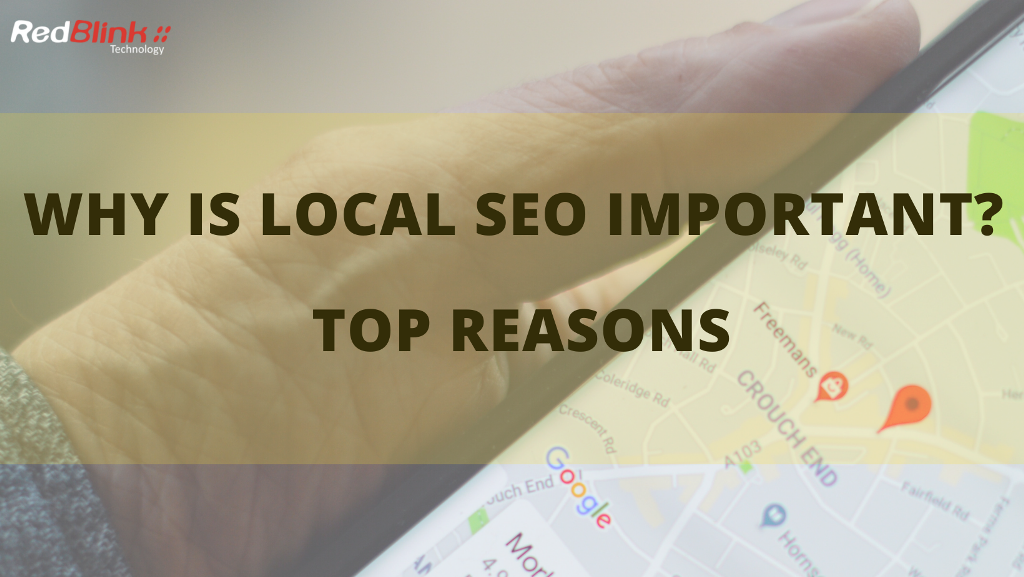
Local Search Engine Optimisation is becoming more and more important as searchers are changing the way they use search engines. There has been a steady increase in searches that include “near me” and are done on mobile since the early 2010s and this trend doesn’t look to be slowing any time soon.
With more searches occurring on mobile devices, users are often not looking to have to click through to a website to find basic information. With local SEO they are able to see a business name, contact information, hours, reviews, and more right on the results page.
Why Small Businesses Need Local SEO ?
Here are a few stats that prove how important local search continues to be for businesses:
(Source: BrightLocal):
- 78% of location-based mobile searches result in an offline purchase.
- 75% of searches for local businesses are done on Google Search, with the remaining 25% on Google Maps.
- 34% of local businesses are seen in more than 1,000 discovery searches per month through their Google Business Profile Page.
- On average, 56% of actions on Google Business Profile listings are website visits.
- 16% of businesses receive more than 100 calls per month through Google Business Profile.
- 83% of searchers use Google Search to learn more about nearby businesses; 55% use Google Maps, 44% Apple Maps, 39% turn to Yahoo, and 31% choose Bing Maps.
- Yelp appears in the top five search results for SMB searches 92% of the time.
(Source: Think with Google) :
- According to Google, 76% of people who conduct a local search on their smartphone visit a business within 24 hours, and 28% of those searches result in a purchase.
- By 2021, mobile devices will influence over $1.4 trillion in local sales.
- 18% of local smartphone searches resulted in a purchase within the day, while only 7% of non-local searches resulted in a sale.
- A recent local SEO survey found that 82% of consumers read online reviews for businesses during a local search and spend close to 14 minutes doing so before making a decision.
- 86% of people rely on Google Maps to find the location of a business. More than half of Internet users worldwide use a mobile device for their local searches.
Learn how to choose Local SEO services for small businesses to make them more efficient by bringing local attention to the world. For a local business, this increases its exposure to relevant customers.
Top Reasons Why Local SEO is so important in 2024
-
More and More People Are Looking for You on Their Mobile
More and more people are searching through mobile devices. This keeps those looking for local businesses on the go. Someone who today is in New York looking for a nearby cafeteria, tomorrow may be in California.
Therefore, if you are well located in your area, it does not matter that the person who is looking for you at that moment does not live in your city, because if he is visiting, he will find you.
-
Not All Companies Work With Local SEO
Although Local SEO is a fundamental element that every company should take into account when developing a marketing strategy, it is not.
Many companies are still unaware of the benefits of proposing a good strategy in this regard. In fact, although Google Business Profiles (previously known as Google My Business) is a free way to advertise on the Internet, there are many companies that have not opened their Company profile on this platform.
This offers you a golden opportunity. The fact that not all companies are working on their local web positioning means that you have many more possibilities of being the best-positioned business against your competition.
Without a doubt, it is a great business opportunity and, as with everything, the fact of arriving before others can give you a certain advantage.
-
Your Own Clients Also Look for You on the Internet
Does your company already know all the people in your city? It is possible that yes. You may not even need to have more clients.
However, even so, Local SEO should be important to you. Did you know that many times, those “regular” clients of a company look for information about it on the Internet?
They may need to know what time you'll be open, what your phone number is, or even share your location with someone who asks them where to find your services.
-
Users Trust the Opinions of Your Customers
Listing your business on Google Business Profiles allows people who don't know you to see the comments of those who have already been your customers.
This, which may seem insignificant, is very important for the user experience. Your potential customers will be able to see if your former customers are happy with your products and services.
If so, they will most likely decide to come to your company. However, if even searching for you directly by your company name, they don't even find a Google Business profile, they won't be able to trust you.
Conclusion - Importance of Local SEO for your business
Understanding why local SEO is important is the first step toward improving your own local SEO. If you want to grow your local customer base, connect with your local community, build brand awareness, and gain a better reputation in your region, taking advantage of the local SEO benefits is the way to go.
We want to help you achieve those benefits.
Find Local SEO services near you - Local SEO Company in Sacramento, CA , Local SEO Services in Henderson NV, Local SEO Services in Reno NV , SEO Services in Anaheim, CA
What Is SOC 2 Compliance - Definition, Types, Requirements
SOC 2 compliance is important for service organizations that want to protect their customers' data. For example, organizations that use a Software-as-a-Service (SaaS) vendor can use SOC 2 to verify that their vendor meets specific security requirements.
Recent data protection laws have entrenched the rights of individuals to privacy and the security of their personal data across the globe.

As personal information becomes more valuable, the frequency and severity of security breaches only increase. Organizations that do not adequately secure their data face the loss of their reputation, but also potentially devastating fines.
Companies are therefore wondering which compliance agreement would be best suited for their organization. At different levels of government, there are regulations in place that define data protection and prescribe stiff penalties for non-compliance.
Here are a few examples, among many:
- In the United States, HIPAA requires healthcare organizations to protect the confidentiality of patient records and medical information.
- In Canada, PIPEDA governs how private companies can collect, use and disclose personal information in the course of commercial activities.
- Internationally, the Payment Card Industry Data Security Standard (PCI DSS) establishes specific standards regarding the protection of account and cardholder data.
- As for the European Union, the general data protection regulation ( RGDP) is based on an individual's "Right to be forgotten" and prescribes data protection and privacy for all individuals living within its territory. Fines for non-compliance can be up to 4% of total annual income.
With so many regulations, standards, and certifications, it's no wonder businesses are confused. Industry standards and approaches have evolved to better protect the data for which they are responsible, yet their variety and complexity make it difficult to know where to begin.
While most have unique and particular requirements, when it comes to privacy and data protection, they all prescribe a common set of best practices.
With standards like the SOC 2 report or recognized certifications like ISO 27001, you'll establish a solid information security foundation and your business will be continuously compliant with ever-changing requirements.
In this blog post, we will not only explain what SOC 2 compliance is, who it is for, what type of the third party performs a SOC 2 audit, and what its Type 1 and Type 2 trust service principles are, but also what are the main differences between SOC 1 and SOC 2 as well as the main advantages of SOC 2 compliance.
What is SOC 2 compliance?
Developed by the American Institute of Certified Public Accountants (AICPA), "Systems and Organizations Controls 2", SOC 2 (or SOC II) is a framework used to help companies demonstrate the security controls that are in place to protect customer data in the cloud.

These controls became known as the Trust Services Principles: Security, Availability, Processing Integrity, Confidentiality and finally Privacy.
SOC 2 was created to give customers confidence that the service providers they use have adequate controls and security measures in place to protect their data.
Unlike the rigorous set of PCI-DSS security requirements, the SOC is more of a framework for organizations to design their own controls as long as they effectively adhere to the principles of trust.
SOC 2 compliance is considered the gold standard for cloud data security in terms of third-party assurance, helping you build trust with customers and reduce the risk of a data breach.
Also Read: 56 Marketing Tools + Resources To Increase Your Productivity
Importance of SOC 2 Compliance
Both SOC 1 and SOC 2 are compliance standards regulated by the AICPA. While SOC 1 aims to help organizations report on internal controls over their customers' financial statements, SOC 2 is more general and assesses a given service provider's controls for various TSCs, namely security, confidentiality, availability, processing integrity and confidentiality.
However, they have different purposes, types of control coverage, audiences, and intended uses, and they are not leveled against each other, as described in the following list:
-
Different types of control coverage
While the SOC 1 audit strictly covers the handling and protection of customer information in business and IT processes, the SOC 2 can cover all five principles, either a given selection of them or all five of them.
-
Different audit audiences
While the objective of the SOC 1 audit is to enable Certified Public Accountants (CPAs) in the management of an organization, external auditors and users to have confidence in the accuracy of its financial statements, the goal of the SOC 2 audit is to provide executives, business partners, and external auditors with an assessment of whether or not their company's security measures meet industry standards.
-
Different uses foreseen by the audit
While SOC 1 helps user entities obtain the impact of service organization controls on their financial statements, SOC 2 helps oversee organizations, vendor management plans, internal corporate governance and management processes risks, as well as regulatory oversight.
You might need a SOC 1 or SOC 2 report if you are an organization hosting client systems, such as an infrastructure as a service (IaaS) or a platform as a service (PaaS), or a cloud hosting software, such as a software-as-a-service (SaaS) entity or data center.
Choosing between SOC 1 and SOC 2 should come down to:
a) the type of compliance requirements you are held to,
b) the type of assurance you need to provide to your customers,
c) and the type of information you are responsible for protection.
Who Does SOC 2 Apply To?
SOC 2 applies to any technology service provider or SaaS business that stores, processes, or transmits customer data, including cloud computing, and managed security.
It also includes healthcare claims management, processing, and automation providers of the sales force.
What are the main benefits of SOC 2 compliance?
SOC 2 compliance has many key benefits, including:
-
Secure business partnerships
SOC 2 compliance can help you build trust and secure business partnerships. If you are a SOC 2-compliant organization, your potential partners will know that you have the necessary controls in place to protect their data.
-
Improve your security measures
SOC 2 compliance can help you identify and improve your security measures in terms of technology and process, which means your organization will be better protected against cyberattacks.
-
Prevent incidents and financial losses
SOC 2 compliance can help you prevent incidents and financial losses that could damage your reputation or legal action against your organization.
-
Protect your brand image and reputation
SOC 2 compliance can help protect your brand image and reputation by demonstrating your commitment to protecting your customers' data. With the latest corporate data breach news going on, showing a security compliance seal will help you earn and maintain customer trust.
-
Attract investors and buyers
SOC 2 compliance can help you attract potential investors and buyers because it demonstrates that you are a responsible and reliable company and that you also have the necessary controls in place to protect their investment.
-
Comply with requirements of other third parties
SOC 2 compliance can also help you comply with other requirements such as PCI-DSS, ISO 27001, and HIPAA, but also with the requirements of your customers and partners if they have SOC 2-related clauses in their contracts.
In short, SOC 2 reports are not just a regulatory compliance exercise for good measure, but also a valuable marketing tool for winning new business.
As noted in our other blog post detailing some of the above benefits of SOC compliance, starting your SOC 2 compliance journey early will allow your organization to thrive in an environment with tight controls, making all your future compliance projects faster and easier to do.
Also Read: SEO Content Writing vs Creative Content Writing- Comparison Guide 2024
What are the key controls of SOC 2?
The Service Organization Control 2 (SOC 2) set of compliance and auditing process requirements was created to help companies determine whether their business partners can properly secure data. This includes protecting the interests of customers from unauthorized access as well as maintaining confidentiality for everyone involved in the transaction process.
The 5 key security controls or Trust Services Criteria (TSC) of SOC 2 are described below:
- Security refers to the protection of information and systems from unauthorized access, use or disclosure, through the use of security systems or processes, including firewalls, encryption, and two-factor user authentication.
- Availability encompasses the accessibility of the system and data, in accordance with the terms specified and agreed upon in a contract or service level agreement (SLA), as well as the ability of the system to perform its required function at specified times.
- Processing integrity ensures that customer data is complete, valid, accurate, timely and authorized, and that processing is carried out in accordance with stated policies and procedures.
- Confidentiality relates to data considered confidential when its access or disclosure is limited to authorized persons, or when its unauthorized access or disclosure would have an adverse impact on customers.
- Privacy covers the collection, use, retention, and disposal of customer data in a manner consistent with an organization's privacy policy and applicable laws and regulations.
What type of third party performs a SOC 2 audit?
A SOC 2 audit must be carried out by a qualified and independent third-party auditor, including CPA (Certified Public Accountant) firms.
The auditor will review the service organization's SOC 2 report and issue a SOC 2 attestation report which will include the auditor's opinion on whether the service organization has met the SOC 2 criteria.
What are SOC 2 Type 1 and Type 2?
Overall, SOC 2 compliance takes about six months with third-party assessors performing two separate audits. The SOC 2 Type 1 audit looks at the design and provides a snapshot of your security processes in place at that time.
The SOC 2 Type 2 audit, on the other hand, will verify the operational effectiveness of your internal controls over the long term. You must complete type 1 as a prerequisite for the type 2 attestation.
Let's learn more about the differences between SOC 2 type 1 and type 2 and determine which to pursue on your path to compliance.
SOC 2 Type 1
SOC 2 Type 1 is a report on a service organization's system and the suitability of the design of controls. The report describes the current systems and controls in place and reviews documents around these controls. Design sufficiency of all Administrative, Technical, and Logical controls are validated.
- The SOC 2 Type I report is an attestation of your company's service organization's controls at a specific time and certifies that these are properly designed and implemented.
- Expect this process to take about two months to allow for policy implementation, testing, and adjustment. Once completed, the booked assessment will typically involve employee interviews, walkthroughs, and a detailed review of submitted documentation.
- A SOC 2 Type 1 report will be generated once all necessary exception clarifications have been made.
- The SOC 2 Type I report is an attestation of your company's service organization's controls over a period of time and certifies that these are properly designed and implemented and are effective.
SOC 2 Type 2
A SOC 2 Type 2 report is an internal controls report capturing how a company safeguards customer data and how well those controls are operating. Companies that use cloud service providers use SOC 2 reports to assess and address the risks associated with third-party technology services.
- In general, SOC 2 Type 2 reports usually last at least six months, but can often take up to a year or more. This is due to many factors involved in the path to attestation, which may be due to company certification requirements that must be met.
- For example, if a company has a very diverse and extensive IT and cybersecurity infrastructure, the audit process will likely take longer than usual for a full SOC report. Other factors affecting the scope of the audit such as the type, location and number of users in the business (i.e. on-site and off-site) will greatly impact the process of attestation.
- Ultimately, though, the primary factor affecting the timeline for completing the SOC 2 process is the type of SOC 2 report your company has selected.
Also Read: 20 Best Nocode Development Platforms & Tools List 2024
Conclusion
Now more than ever, the continued success of your business depends on trust. Trust of your employees, your partners and especially your customers. SOC 2 compliance is the best way to ensure that trust.
Not only does this help secure your customer data, but it also helps differentiate your business in the marketplace. For any business that puts customer trust first, SOC 2 compliance is the way to go.
Complying early has several advantages, in particular, because it is much easier to meet the requirements when your company still has few employees and few departments. If you wait for your business to grow, the process will become much more complicated and expensive.
Another benefit of starting early is that your business will grow in an environment with tighter controls that will help make compliance assessments faster and easier to perform in the future, no matter the size of the business.
SOC 2 compliance is not a one-time event, but rather an ongoing journey that requires the commitment of the entire organization.
FAQs - SOC 2 Compliance
1. Is a SOC 2 Report HIPAA Compliant?
The answer is no, but SOC 2 compliance can also help you comply with other requirements such as PCI-DSS , ISO 27001 and HIPAA, but also with the requirements of your customers and partners if they have SOC 2-related clauses in their contracts.
In short, SOC 2 reports are not just a regulatory compliance exercise for good measure, but also a valuable marketing tool for winning new business.
There are several areas required by the HIPAA security rule that is not covered by a SOC 2. These include passwords, biometrics, physical security, transportation of PHI, and remote access.
To keep things simple, in this scenario we will compare a SOC 2 that only covers security criteria to a report that covers HIPAA security compliance.
2. What is the First Step Towards HIPAA Compliance?
The first step toward HIPAA Compliance is doing your research to determine if you are a covered entity. Once you determine that the HIPAA Security Rule applies to your organization, finding a reputable firm to assist in performing a readiness assessment is a great next step.
A readiness assessment will help identify gaps that need to be addressed prior to undergoing the HIPAA compliance audit and will assist you in creating a robust control environment.
3. How is SOC 2 Type 2 different than Type 1?
SOC 2 reports come in two flavors: Type 1 and Type 2. Here is the description of the differences between the two:
- The SOC 2 Type 1 report is a report on a service organization's system and control design adequacy. The Type 1 report looks at a point in time on how the organization describes the system and controls in place. In addition, this review ensures that the controls described allowing the criteria to be met.
- The SOC 2 Type 2 report is similar to the Type 1 report, but the controls are described and evaluated for at least six months to see if they are operating as defined by management.

